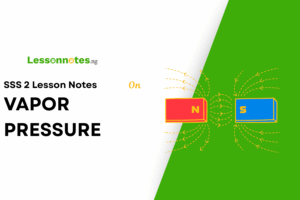Heat Energy SS2 Physics Lesson Note
Download Lesson NoteTopic: Heat Energy
HEAT
Heat is a measure of the internal energy of a body. It is a form of energy due to a temperature difference. It is measured in Joule, J
TEMPERATURE
Temperature is the degree of hotness or coldness of a body. The unit of temperature is in degrdegreesius (0C) or Kelvin (K)
Measurement Of Temperature
Temperature is measured by using thermometers. Thermometers have two reference temperatures or fixed points called the upper fixed point and lower fixed point.
The upper fixed point is the temperature of steam from pure water boiling at a standard atmospheric pressure760mm of mercury. It is 100°C. The lower fixed point is the temperature of pure melting ice at the standard atmospheric pressure of 760mm of mercury. It is 0°C
Temperature Scales
The difference in temperature between the upper and lower fixed points is called the fundamental interval of a thermometer. The calibration of this interval depends on any of the three scales below:
- Celsius scale
- Fahrenheit scale
- Kelvin or Absolute scale
The S.I.Unit of temperature is the Kelvin. However, it is also measured in degrees Celsius and Fahrenheit.
THERMOMETERS
Thermometers are instruments used to measure temperature. They are named using the thermometric properties employed in the measurement of temperature.
Each thermometer makes use of the change in the physical properties of materials they are made of, to indicate temperature change.
| SN | NAME OF THERMOMETER | THERMOMETRIC SUBSTANCE | THERMOMETRIC SUBSTANCE | ADVANTAGE |
| 1 | Liquid-in-glass thermometer | Alcohol or mercury | Change in the volume of the liquid with temperature | Portable and easy to use |
| 2 | Gas Thermometer | Gas | Change of gas pressure at constant volume with temperature | Accurate measurement of temperature and gives wider ranges of temperature |
| 3 | Thermocouple thermometer | Two dissimilar metals | Changes in the e.m.f. Between two different metals kept at different temperatures | Quick response to temperature changes and wider ranges of temperature |
| 4 | Resistance thermometer | Resistance wire | Change in electrical resistance of wire with temperature | It responds to a small change in temperature, it is very accurate and measures a wide range of temperature |
| 5 | Bimetallic thermometer | Two different metals | The differential expansion of the two metals of the bimetallic strip |
- The Liquid-in-glass Thermometer: The liquid-in-glass thermometer depends on the uniform expansivity of the liquid used with temperature change. Any liquid that will be used as a thermometric liquid must be a good conductor of heat, be easily seen in glass, have a high boiling point, have a low freezing point, have a low specific heat capacity, must not wet glass and must expand uniformly.
- The Clinical Thermometer: This has a constriction and it has a short range (350C – 430C). The narrow constriction prevents the mercury from flowing back into the bulb immediately after the thermometer has been removed from the patient’s body.
- Platinum Resistance Thermometer: This thermometer depends on the variation in the electrical resistance of a conductor with temperature as expressed below:
Rt – R0 = t
R100 – R0 100
Rt = resistance of temperature at t°C
R0 = resistance at 0°C
R100 = resistance at 100°C
- The Thermocouple: A thermocouple consists of two different metals joined together by a circuit containing a galvanometer. The working of a thermocouple depends on the variation of the electromotive force (e.m.f) between junctions. The equation of the relationship is E = a + bt + ct², where a, b and c are constants
- Constant–Volume ass Thermometer: This depends on the variation in the pressure of a gas at constant volume with changes in the temperature of the gas.
The equation is: P1 = P2
T1 T2
ABSOLUTE SCALE OF TEMPERATURE
Temperature has no property of direction but has magnitude or size, which depends on the scale being used. The absolute scale of temperature is thermodynamic because it gives us the idea of the lowest possible temperature or absolute zero with the value of –2730K.
The absolute zero is the lowest possible temperature below which nothing can be cooled since temperature is the measure of the average or mean kinetic energy of the molecules of a substance. It follows that as we subtract heat from a substance, its temperature drops and hence its kinetic energy until it eventually becomes zero under which the molecules remain stationary.
The Celsius seal is the most commonly used scale. This scale is based on two fixed points – the lower fixed point (O0C) and the upper fixed point (1000C). The gap between these points is called the fundamental interval.
ASSIGNMENT
- What is temperature?
- Distinguish between temperature and heat.
- Give three advantages of mercury over alcohol as a thermometric liquid.
- The pressure at the ice point for a constant volume gas is 4.81×104Pa. While that of the steam point is 6.48×104Pa. What temperature will this thermometer indicate at 50°C?






















